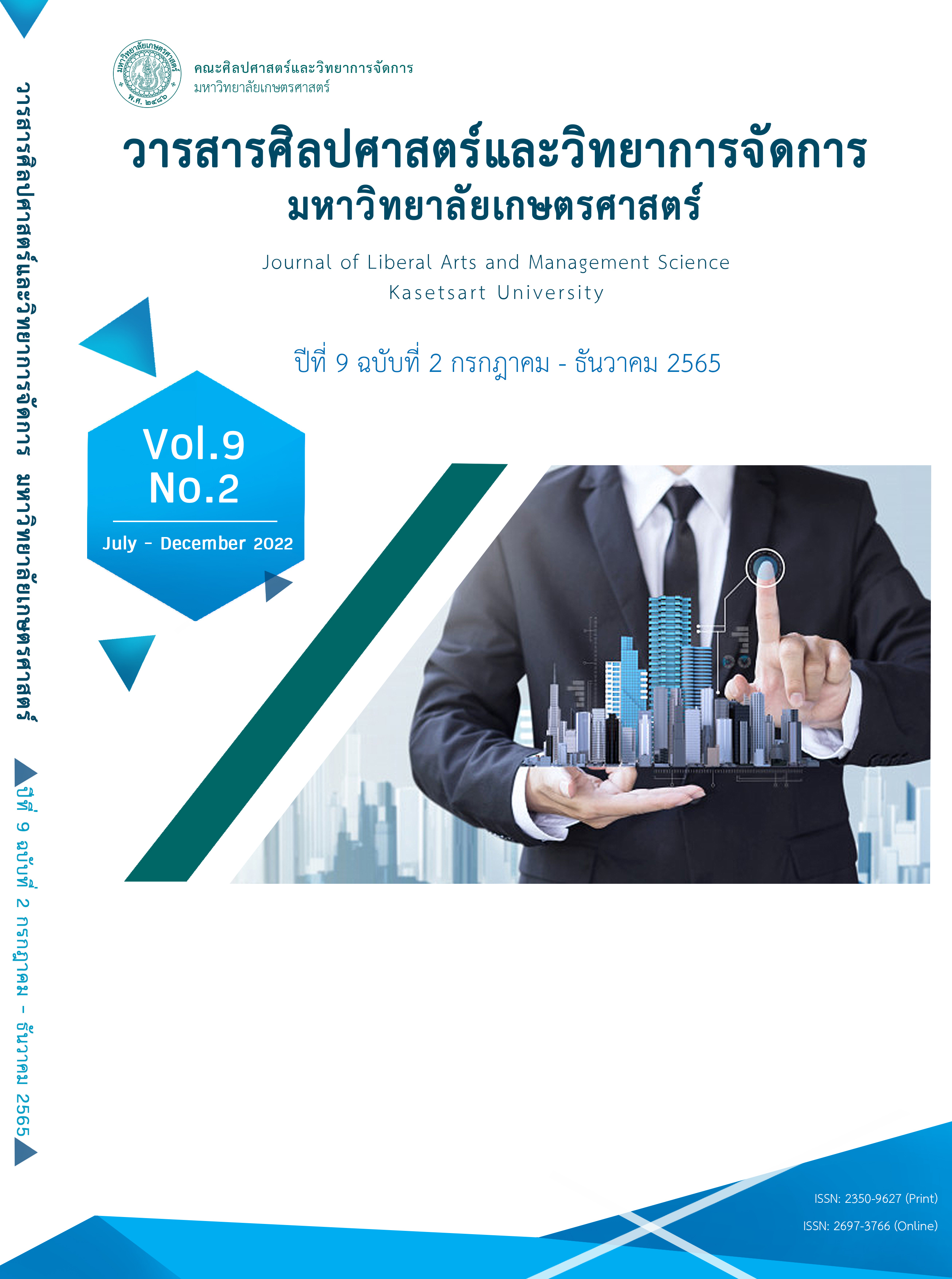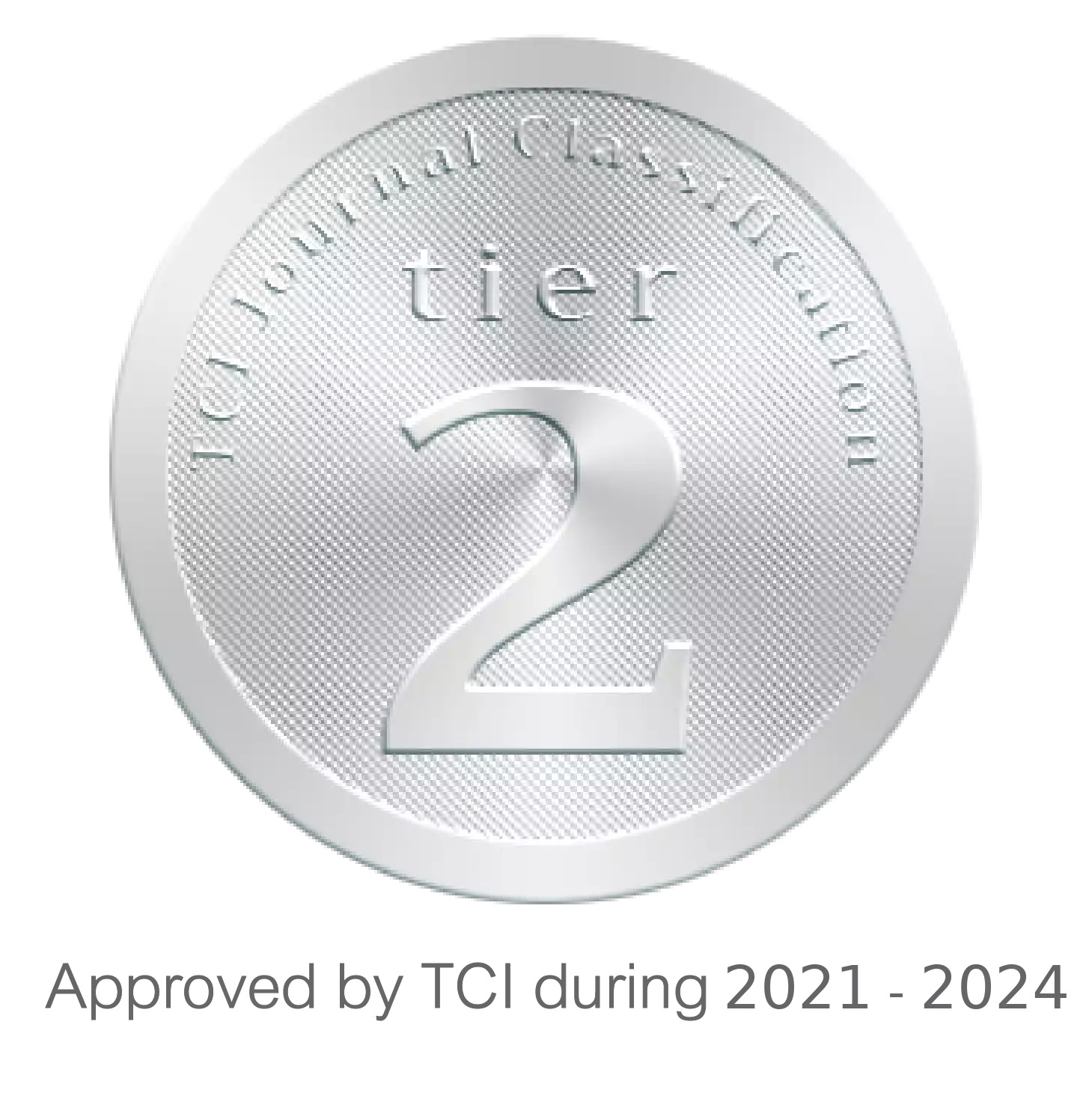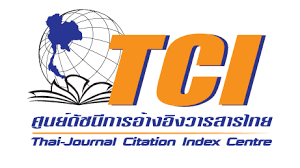INTERIOR DESIGN ELEMENTS INFLUENCING THE DECISION TO USE A HOTEL BUSINESS AMONG GENERATION Z TRAVELERS, CASE STUDY OF HOTEL BUSINESSES IN POM PRAP SATTRU PHAI DISTRICT, BANGKOK
Keywords:
Hotel interior design, decision, Generation Z travelersAbstract
The objectives of this research were 1) to study the interior design elements of the hotel business for Generation Z travelers; and 2) to investigate the interior design elements that influence the decision to use the hotel business of Generation Z travelers. This research applied mixed method research, including in-depth interviews with 4 hotel operators from 3-4 star-hotels in Pom Prap Sattru Phai District. The sample used in the research was 184 generation Z travelers calculated with the G*power program and the data were analyzed with percentage, mean, standard deviation, Pearson’s correlation coefficient, and multiple regression analysis. The findings revealed that Interior elements are at the highest level. When classifying aspects, it was found that utilities and building engineering systems were found It's the most average. According to the multiple regression analysis, it revealed that the five most influential interior design elements are psychology in design, comfort and ease of use, public utilities and building engineering systems, use of space size, photography, and marketing promotion of the hotel. These affects the decision to choose the hotel services of generation Z travelers.
Downloads
References
กรมการท่องเที่ยว. (2563). คู่มือการปฏิบัติตามมาตรการผ่อนปรนกิจการและกิจกรรมด้านการท่องเที่ยวเพื่อป้องกันการแพร่ระบาดของโรคติดเชื้อไวรัสโคโรนา 2019 (COVID-19). สืบค้นเมื่อ 17 กรกฎาคม 2564, จาก https://www.thailandsha.com/file/COVID-19_th.pdf.
กรมสุขภาพจิต. (2564). Gen Y/Gen Me กลุ่มผู้กุมชะตาโลก. (ออนไลน์). สืบค้นเมื่อ 19 กรกฎาคม 2564, จาก https://www.dmh.go.th/news/view.asp?id=1251.
กรวรรณ งามวรธรรม และลลิตา นุ่มไทย. (2563). ถอดรหัสงานศิลป์ของศิลปินไทยเพื่อสร้างสรรค์สภาพแวดล้อมภายในโรงแรมบูติค. วารสารศิลปกรรมศาสตร์วิชาการ วิจัย และงานสร้างสรรค์, 7(1), 149-170.
สำนักงานปลัดกระทรวงการท่องเที่ยวและกีฬา. (2563). รายงานภาวะเศรษฐกิจการท่องเที่ยว COVID-19 กับผลกระทบต่อการท่องเที่ยวไทย. บริษัท เอ็กเซลเลนท์บิสเนสแมเนจเม้นท์ จำกัด.
การท่องเที่ยวแห่งประเทศไทย. (2563). แผนการดำเนินโครงการแนวทางความปลอดภัยด้านสุขอนามัย. กรุงเทพมหานคร: ฝ่ายพัฒนาสินค้าการท่องเที่ยวด้านสินค้าและธุรกิจท่องเที่ยวการท่องเที่ยวแห่งประเทศไทย.
กิตติศักดิ์ เตชะกาญจนกิจ. (ม.ป.ป.). หลักการออกแบบตกแต่งภายในพื้นที่พักอาศัย. กรุงเทพมหานคร: มหาวิทยาลัยราชภัฏสวนสุนันทา.
จง บุญประชา. (2557). การออกแบบตกแต่งภายใน. กรุงเทพมหานคร: คณะเทคโนโลยีอุตสาหกรรม สถาบันราชภัฎสวนสุนันทา.
จักรกฤษณ์ เหลืองเจริญรัตน์. (2564). “โรงแรม” หลังโควิด 19 ต้อง “ดีไซน์” อย่างไร?. สืบค้นเมื่อ 14 มีนาคม 2564, จาก https://www.terrabkk.com/articles/199544/-“โรงแรม”-หลังโควิด-19-ต้อง-“ดีไซน์”-อย่างไร-.
ณัฎฐ์ชยกร ภัทราศิริธนิศร. (2562). การดัดแปลงอาคารประเภทตึกแถวเก่าตามข้อกฎหมายเพื่อใช้ประโยชน์เป็นโฮสเทล กรณีศึกษา โฮสเทลในเขตบางรัก. วารสารวิชาการมหาวิทยาลัยราชภัฏอุดรธานี, 7(2), 61-75.
ดนุลดา จามจุรี. (2563). การออกแบบการเรียนรู้สำหรับผู้เรียน Gen Z. กรุงเทพมหานคร: บัณฑิตวิทยาลัย มหาวิทยาลัยศรีนครินทรวิโรฒ.
ไตรรัตน์ จารุทัศน์. (2558). คู่มือการออกแบบเพื่อทุกคน. กรุงเทพมหานคร: โรงพิมพ์เทพเพ็ญวานิสย์.
ทศพร บุญวัชราภัย, วิโรจน์ เจษฎาลักษณ์, และขวัญฤดี ตันตระบัณฑิตย์. (2559). ความคิดสร้างสรรค์ขององค์กรและนวัตกรรมบริการของโรงแรมบูติกไทย. วารสารวิชาการสาขามนุษยศาสตร์ สังคมศาสตร์ และศิลปะ, 9(3), 1242-1259.
ทวีศักดิ์ ฤกษ์สวัสดิ์ถาวร. (2563). แนวทางการปรับปรุงทางกายภาพโครงการอาคารชุดให้เป็นโรงแรมกรณีศึกษาโครงการโรงแรมระดับ 4 ดาว ในพื้นที่พัทยา. สาระศาสตร์, 64(1), 88-100.
ทิพย์สุคนธ์ อิทธิประทีป. (2560). ศิลปะป๊อบในงานตกแต่งภายในโรงแรมบูติค กรณีศึกษาโรงแรมมิสติค เพลส รูมส์อิน บางกอก. วารสารวิชาการบัณฑิตวิทยาลัยฉบับภาษาไทย สาขามนุษยศาสตร์ สังคมศาสตร์ และศิลปะ มหาวิทยาลัยศิลปากร, 10(2), 2895-2908.
นุชนารถ กฤษณรมย์ และปรีดา นัคเร. (2563). การพัฒนาการท่องเที่ยวโดยชุมชนที่สอดคล้องกับพฤติกรรมและความต้องการของนักท่องเที่ยว กรณีอําเภอนบพิตํา จังหวัดนครศรีธรรมราช. วารสารนาคบุตรปริทรรศน์ มหาวิทยาลัยราชภัฏนครศรีธรรมราช, 13(1), 129-140.
พรสวรรค์ ชัยมีแรง, อุมาวรรณ วาทกิจ. (2563). กลยุทธ์การจัดการด้านการตลาด โดยใช้การพาณิชย์ผ่านเครือข่ายสังคมออนไลน์ ในธุรกิจโรงแรมขนาดกลางและขนาดเล็ก ในเขตภาคตะวันออกเฉียงเหนือ ตอนกลาง. วารสารสังคมศาสตร์และมนุษยวิทยาเชิงพุทธ, 5(9), 411-424.
พรสวรรค์ บุญสถิตย์, อรจิรา สันติวราคม และ สุทธิชัย ทองเขาอ่อน. (2563). พอสเทล: เทรนด์ใหม่ของธุรกิจโรงแรมในยุคไทยแลนด์ 4.0. วารสารครุศาสตร์ปริทรรศน์ คณะครุศาสตร์ มหาวิทยาลัยมหาจุฬาลงกรณราชวิทยาลัย, 7(1), 300-317.
ระชานนท์ ทวีผล และ ณัฐพล เขียวงาม. (2563). การกําหนดกลยุทธ์ทางการตลาดแบบแรงดึงดูดเพื่อการดําเนินธุรกิจผ่านสื่อสังคมออนไลน์อินสตาแกรมของกลุ่มผู้ประกอบการในสถาบันอุดมศึกษากรณีศึกษา มหาวิทยาลัยศิลปากร วิทยาเขตสารสนเทศเพชรบุรี. วารสารมนุษยศาสตร์และสังคมศาสตร์ มหาวิทยาลัยราชภัฏสวนสุนันทา, 3(1), 62-74.
วิไลวรรณ พานทอง, กวีวรรณ อินทรชาธร. (2563). สภาพแวดล้อมของอาคารเรียนสถาปัตยกรรรมที่เอื้อต่อการเรียนรู้ด้วยตนเองกรณีศึกษามหาวิทยาลัยเทคโนโลยีราชมงคลอีสาน. วารสารครุศาสตร์อุตสาหกรรม, 19(2), 118-128.
ศูนย์สร้างสรรค์งานออกแบบ สํานักงานบริหารและพัฒนาองค์ความรู้. (2561). เจาะเทรนด์โลก 2019. กรุงเทพมหานคร: ศูนย์สร้างสรรค์งานออกแบบสังกัดสำนักงานบริหาร และพัฒนาองค์ความรู้ (องค์การมหาชน).
ศูนย์วิจัยกสิกร. (2563). โค้งสุดท้ายปี 63 คนไทยอยากเที่ยวไทย แต่กังวลโควิด เศรษฐกิจ การเมือง. สืบค้นเมื่อ 22 สิงหาคม 2564, จาก https://www.kasikornresearch.com/th /analysis/k-social-media/Pages/Thai-Travel-Thai-FB-061120.aspx.
สํานักงานเขตป้อมปราบศัตรูพ่าย. (2563). แผนปฏิบัติราชการประจําปี พ.ศ.2563. สืบค้นเมื่อ 22 ตุลาคม 2564, จาก http://www.bangkok.go.th/upload/user/00000083 /General/ DownloadPDF/2463.pdf.
สำนักยุทธศาสตร์และประเมินผล กรุงเทพมหานคร. (2556). แผนพัฒนากรุงเทพมหานครระยะ20ปี (พ.ศ. 2556-2575). สืบค้นเมื่อ 17 พฤศจิกายน 2565, จาก http://www.bangkok.go.th/ upload/user/00000073/web/ita/O4.pdf
เอกพงษ์ ตรีตรง. (2559). การเสนอแนะแนวทางการออกแบบสภาพแวดล้อมภายในโรงแรมขนาดเล็กในต่างจังหวัดเพื่อส่งเสริมศักยภาพการท่องเที่ยวไทย. นครปฐม: มหาวิทยาลัยศิลปากร
Achala, W. S., and Shantha A. (2019). The Impact of Interior and Exterior Designs on Demand for Hotels. A Paradigm Shift of Thoughts and Policies: The Need of the Hour for Developing Economies, (2019), 244-247.
Adem, S. (2020). A systematic literature review on hotel design. Tourism Academic Journal, 20(2), 297-310.
Archer, L. B. (1965). Systematic Method for Designers. London : Council for Industrial Design.
Baek, J., and Ok, C. M. (2017). The power of design:How does design affect consumers’ online hotel booking?. International Journal of Hospitality Management, 65(2017), 1-10.
Barnard, C. T. (1938). The Functions of the Executive. Cambridge: Harvard University Press.
Cronbach, L. J. (1990). Essentials of Psychological Testing. New York: Harper Collins.
Denzin, N.K. (1970). The research act: A theoretical introduction to sociological methods. Chicago: Aldine.
Dunne, P. M., Lusch., R.F. (2008). Retailing. Mason DH: South-Western College Pub.
Fahmawee, A. (2018). Architectural functional design for hotels extension in Amman: A Days Inn Hotel case study. Journal of Engg. Research, 6(4), 1-23.
Faul, F., Erdfelder, E., and Buchner, A. (2017). G*Power 3: A flexible statistical power analysis program for the social, behavioral, and biomedical sciences. Behavior Research Methods, 39(2), 175-191.
Hwang, S., and Ryu, G. (2022). A study on the interior design of a Dog-Friendly Hotel using deepfake DID for alleviation of pet loss syndrome. International Journal of Advanced Culture Technology, 10(1), 248-252.
Mannheim, K. (1952). The problem of generation. London: Routledge and Kegan Paul.
Primadewi, N. P. S., Sueca, P. N., Dwijendra Acwin, K. N., and Siwalatri Ayu, K. N. (2021). Emerging Architect's Design Method in Designing Tourist Accommodation Case Study: Tourist Accommodation in Ubud, Bali. Civil Engineering and Architecture, 9(2), 271-280.
Rovinelli, R. J., and Hambleton, R. K. (1977). On the use of content specialist in the assessment of criterion-referenced test ítem validity. Dutch Journal of Educational Research, 2, 49-60.
Simon, H. A. (1960). The New Science of Management Decision. New York: Harper and Row.
Sriprom, C., Rungswang, A., Sukwitthayakul, C., & Chansri, N. (2019). Personality Traits of Thai Gen Z Undergraduates: Challenges in the EFL Classroom?. PASAA: Journal of Language Teaching and Learning in Thailand, 57, 165-190.
Truter, L. (2022). Universal Design and the Access Rights of Persons with Disabilities. TFM Magazine, 2022(24), 44-46.
Utari, U., and Utami, W. (2020). Hotel Resort Paropo With Neo Vernacular Approach. International Journal of Architecture and Urbanism, 4(1), 23-29.
Wittmann-Wurzer, A. J., and Zech, N. (2019). What are the determinants of European hotel room design 2030?. Worldwide Hospitality and Tourism Themes, 11(2), 155-165.
Xingyi, H. (2020). An old warehouse–A modern hotel: Design techniques in renovation design (using the example of OVOLO 1888 hotel in Sydney). Kharkiv State Academy of Design and Arts: Ukraine.
Rawal, Y. S., Pal, S., Bagchi, P., & Dani, R. (2020). Hygiene and Safety: A Review of the Hotel Industry in the Era of COVID-19 Pandemic. Bioscience Biotechnology Research Communications, 13(10), 79-83.









